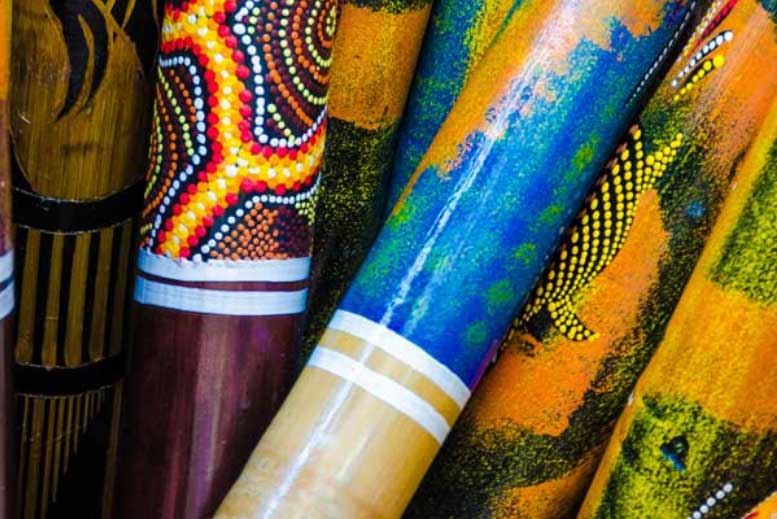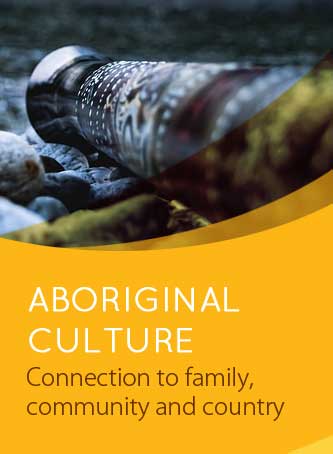The Digeridoo
Who plays the didgeridoo?
The didgeridoo was not used by mobs in the area now know as NSW Central Coast until after European settlement when people became a lot more mobile and travelled much further than they would have done previously.
How is a didgeridoo made?
The didgeridoo is mostly made by nature. People would walk through the bush knocking on tree trunks with a stick until they found one that had been hollowed out by termites. Ceremony would be performed as the ancestral spirit in the tree was asked permission to give up the didgeridoo. The tree trunk would then be harvested, treated, dried to harden it, and sometimes artwork telling a story would be engraved or burned or painted on to it. The sound or ‘voice’ of the didgeridoo is the voice of the ancestral spirit of that tree, so you would never make more than one didgeridoo from a tree. The didgeridoo is always stored upright to keep the ancestral spirit safe.
How is the didgeridoo played?
You dont’ blow air into a didgeridoo. You make a continual buzz with your lips – a bit like “blowing rasberries”. To play continuously, air is held in the mouth and pushed into the digeridoo with the cheeks while air is drawn in through the nose and down into the lungs – this is called Circular Breathing. The sounds that emanate from the dideridoo are made from a combination of the continuous or rythmnic “buzz”, changing the shape of the mouth by moving the tongue, cheeks, chin and teeth, and voice sounds. As with air instruments like the flute, loudness is affected by resonance and not by blowing hard. The harder you blow, the less noise you can make!

Men and women and the didgeridoo
In November 1993, Madonna played a didgeridoo, that she had been given as a gift, on international television. The press reported that Aboriginal Australians were furious as women should not play the didgeridoo. This made international headlines which whipped up a now widely held belief that women should never, in any circumstances, play the didgeridoo. As so often is seen with the media, the story over-simplified a very complex issue.
The didgeridoo is a very important tradional ceremonial instrument. Traditionally, it was not played for musical entertainment, not even by men. It was played in ceremony. However, Australia is a very big place and very many mobs and peoples lived on this continent, all with different ceremonies specific to their Place or Country. For some people, it would have been taboo for women to play the didgeridoo. For others, this may not have been taboo, even if it was not the norm for women to play it. There is some evidence that, in some mobs, women played the didgeridoo as part of Women’s Business.
People have knowledge and stories of their own Place. Most people would not know stories and traditions of those who lived far away and with whom they had no contact. As with all Aboriginal story and ceremony, people from one Place will not claim knowledge of another Place. ‘Not taking other people’s stories’ is a very important part of Aboriginal lore. Most knowledge holders would say “for my people and in my Place, this is not ok” or “for my people and in my Place this is ok”. Aboriginal people would not claim a universal rule applying to all Aboriginal people.
All that being said, using any indigenous person’s tools or art or stories or instruments should never be done without permission and respect. Even men should be aware of the importance of the didgeridoo and should ensure they have permission from the people of a Place where they wish to play it. Always be conscious that the didgeridoo is far more than a musical instrument, and should be played and cared for with the utmost respect for the traditional owners.
Where does the word “didgeridoo” come from?
Origins of the word researched by Toby Beaglehole http://en.wikipedia.org/wiki/Didgeridoo
“Didgeridoo” is usually considered to be an onomatopoetic word of Western invention, but it has been said that it may be derived from the Irish words dúdaire or dúidire, meaning variously ‘trumpeter; constant smoker, puffer; long-necked person, eavesdropper; hummer, crooner’ and dubh, meaning “black” (or duth, meaning “native”). It is alleged that upon seeing the instrument played for the first time, a British army Officer turned to his Gaelic aide and asked “What’s that?”, to which the aide bemusedly replied, “dúdaire dubh,” meaning ‘black piper.’ However, this is unlikely as the Irish word for a black person is actually fear gorm (literally “blue person”).
The earliest occurrences of the word in print include the Australian National Dictionary 1919, The Bulletin in 1924 and the writings of Herbert Basedow in 1926. There are numerous names for this instrument among the Aboriginal people of northern Australia, with yirdaki one of the better known words in modern Western society. Yirdaki, also sometimes spelt yidaki, refers to the specific type of instrument made and used by the Yolngu people of north-east Arnhem Land. In Western Arnhem Land, mago is used, although it refers specifically to the local version. Many believe that it is a matter of etiquette to reserve tribal names for tribal instruments, though retailers and businesses have been quick to exploit these special names for generic tourist-oriented instruments.
What is the didgeridoo used for?
The didgeridoo is an Aboriginal instrument which, traditionally, is important in Aboriginal ceremony. It is musical, and today it is used to play contemporary music, but traditionally this was not the role of the didgeridoo. The voice of the didgeridoo was part of story telling and teaching.


